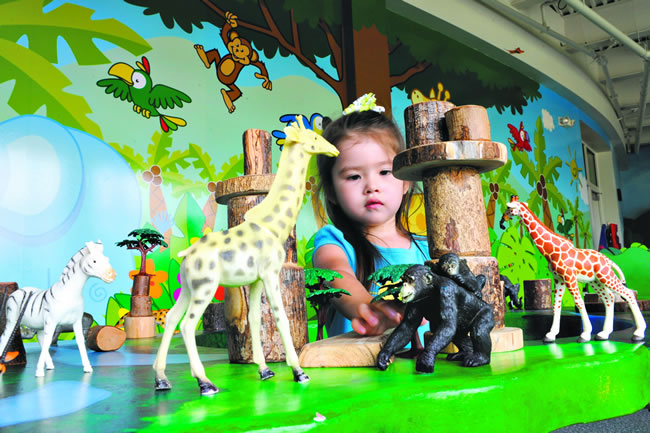Rainforest Education Comes Alive
Hawaii Children’s Discovery Center’s newest Rainforest Adventures exhibit aims to educate young students about one of the Islands’ precious resources
Our shared Earth pulsates with life by day and night. Throughout our daily routines we get hints of its effortless cycle, by glancing at a blooming flower, listening to a puppy’s buoyant bark or smelling the freshness of countless raindrops slowly evaporating as the sun peeks its rays through a breaking storm.
Hidden under the expansive lushness of tree canopies in various pockets of the world is a living Earth where growth and regrowth is boundlessly abundant, intricate and at its finest, completely natural. These are our rainforests, from the temperate cooler ecosystems found in the Americas, Europe, Asia and Australia to the tropical variety that flourishes between the Tropics of Cancer and Capricorn. Utilizing the immense amount of rain (50-125 inches annually) that is recycled from its own vegetation, rainforests produce thousands of ingredients and resources we use on a daily basis, from foods to medicinal extractions.
Rainforest Adventures
And yet, to most people, the rainforests’ inner workings remain a mystery. Hawaii Children’s Discovery Center is opening its educational avenues so these invaluable environments can be understood a bit more by both children and adults. On Saturday June 30th, its Rainforest Adventure exhibit opens to the public.
“We wanted to do something in the sciences, and when the rainforest came up, we thought it was great because preservation of the environment is so important,” says Liane Usher, Hawaii Children Discovery Center’s director of exhibits and programs.
Rainforest Adventures is quite fitting, as Hawaii is the only state in the U.S. that is home to tropical rainforests, and yet there is not an abundant amount of information about them available to the public.
The exhibit will combine information about both our local rainforests and those throughout the world.
Before constructing and organizing Rainforest Adventures, the faculty and staff at Children’s Discovery Center took their own field trip to the Waihee Watershed tunnels to get a better understanding of
Hawaii’s rainforest water cycle.
“Our trip was really educational and fun. It puts you in tune with the aina, and that put us in the mindset as we prepared to develop this exhibit,” says Loretta Yajima, president and CEO of Children’s Discovery Center.
A process-driven exhibit, Rainforest Adventures uses hands-on sensory function to engage young students. A few attractions of Rainforest Adventures are Amazon River water table, Rainforest Scents Center – where children will use their sense of smell to identify products that come from the rainforest – and the From Rainforest to Home display, in which children identify products that come from rainforest plants, such as rubber from Hevea trees, chocolate from cacao trees or perfumes that come from the rosewood tree.
Replicating scientific research methods, there also is an observation deck for students to look out from.
“We wanted to include an observation deck, because in actual rainforests this is how scientists study the rainforests, from the canopies of the trees,” says Usher.
Children’s Discovery Center understands the new Rainforest Adventures is a work in progress that is supposed to evolve in order to improve its functionality and value. Starting soon, the center will conduct focus group visits to gather feedback and evaluation from both students and educators.
“We are really excited about doing the focus group visits because that’s where a lot of the content about the rainforest and conservation is going to come from. We also will be giving the kids activities that can be taken back to the classroom, and so it should really affect our whole community of learners,” says Yajima.
Promoting conservational and preservation activity, Rainforest Adventures will help educate students about threats to each rainforest, including those that are most specific to our island forests.
“Threats here are so much different than others. Our main threats are invasive plants and animals, and so we thought it was a very important message because children may not understand what affects our ecosystems and why,” adds Usher.
Many community partners, such as Hawaii Nature Center, Board of Water Supply, Kokua Hawaii Foundation, Coordinating Group on Alien Pest Species and The Department of Forestry and Wildlife, will be on hand opening day, participating with variety of fun activities.
With 10,000 to 15,000 school-children visiting Children’s Discovery Center’s exhibits annually, Rainforest Adventures is another stellar platform on which education through interactive learning is the focal theme.







